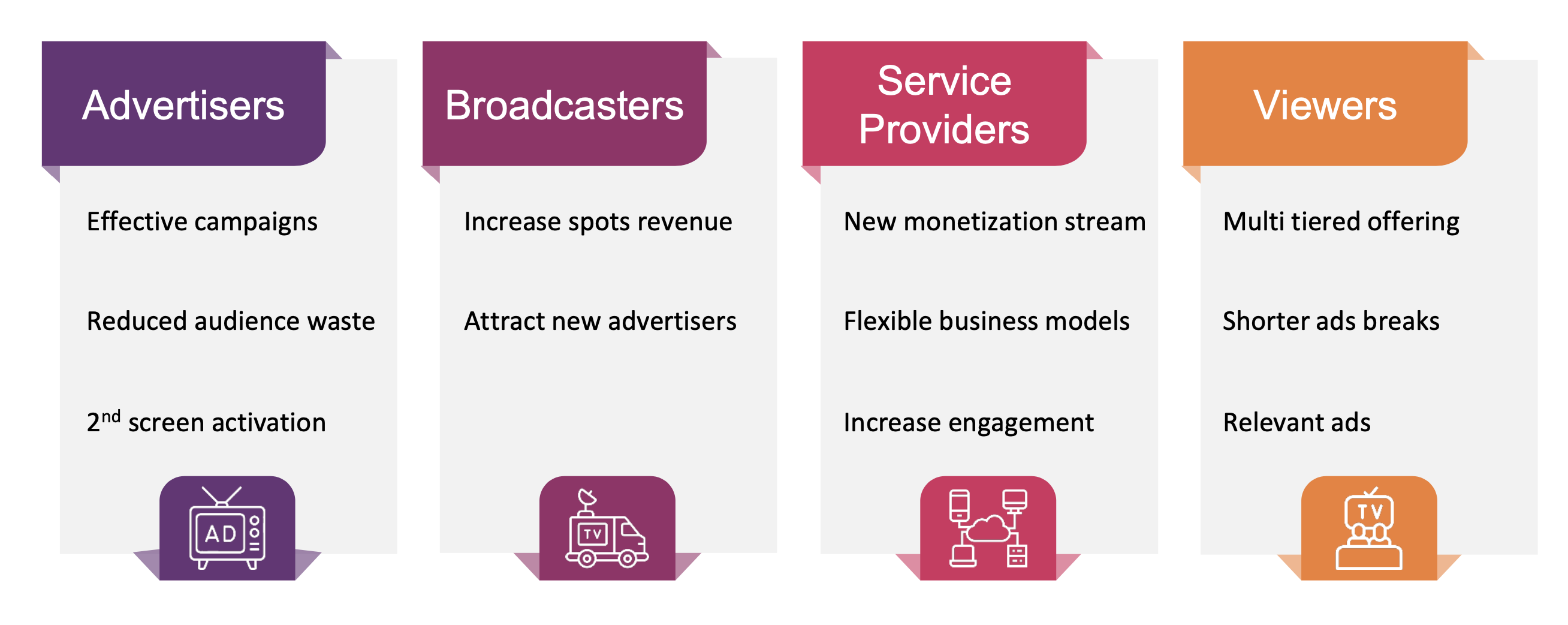The future of tv advertising is headed toward addressable marketing. Discover how to leverage these seven essential strategies to harness the advantages of targeted TV advertising with Thu Do Multimedia!
A peek at the current market
In the wake of the 2020 pandemic-induced downturn, TV ad spending has not only rebounded but is still on a growth trajectory. Furthermore, the share of investments allocated to targeted TV advertising campaigns within the overall landscape continues to expand. For instance, according to statistics from eMarketer, the total post-pandemic TV ad spending in the United States is projected to rise by 17.7% to reach $93.33 billion between 2021 and 2025. Notably, a substantial portion of this growth is attributed to Connected TV (CTV) campaigns.
The percentage of funds allocated to TV advertising is anticipated to increase from 16.9% to 29.4%, ultimately reaching $27.47 billion by 2025. It’s important to note that this figure does not include network-sold inventory in addressable advertising, so the actual total is likely higher.
When we extend these figures on a global scale, the potential is staggering. Targeted TV advertising is one of those rare scenarios where all stakeholders stand to benefit. I recently delivered a presentation on this subject at NAB, titled “The Pillars for Building a Successful IPTV and OTT TV Advertising Business,” and our presentation slide aptly illustrates this concept.

From advertisers to broadcasters, service providers, and viewers, Targeted Advertising brings benefits all throughout the chain. But to do that effectively it has to be set up in the right way. Here are seven key attributes you need to consider when it comes to launching your own targeted advertising solution.
7 keys to unlock the future of TV advertising
1. Everything everywhere all at once

You also require a solution that has the capability to accommodate the entire spectrum of advertising formats that can be displayed in the modern broadcast ecosystem. Even if you do not have immediate plans to use all of these formats, you want the flexibility to offer pre-roll, mid-roll, display banners, event-driven banners, content overlays, and more.
In essence, what you’re seeking is a solution that empowers you to facilitate any kind of advertising display on any platform, any service, and on any screen. The television audience has become increasingly diversified over the past decade, and television advertising not only needs to be compatible with a wide array of screens and devices but also adaptable to various viewing modes in TV advertising.
From traditional live linear TV to time-shifted viewing and Video on Demand, viewers mix and match different options to suit their preferences and moods. Neglecting any of these options can result in missed revenue and opportunities.
2. Give viewers the choice
One highly effective strategy in the market is to provide viewers with the option to select from different tiers of monthly subscription costs, each associated with a specific ad load. Here’s an example of how these tiers can be structured in TV advertising:
Free Tier: This tier doesn’t require a monthly payment and is supported by multiple pre-roll and event-based ads, along with scheduled mid-roll ads.
Economy Tier: Priced at, for instance, $5 per month, this tier offers a reduced ad load, including a single pre-roll and event-based ads.
Premium Tier: For those willing to pay more, let’s say $9 a month, this tier offers an ad-free experience with no ads.
The free tier essentially serves as a customer acquisition funnel, attracting users who can later be targeted for upselling to the paid tiers. Additionally, it’s possible to introduce exclusive content or features as an incentive for users to upgrade their subscription. This tiered approach provides viewers with choices and allows the service to cater to a broader range of preferences and budgets, enhancing user engagement and revenue potential.
3. Gain meaningful insights with TV advertising
Legislation like the EU’s GDPR has had a profound impact on the ad tech ecosystem, pushing it to rely more heavily on first-party data. First-party data refers to the information a company has about its customers and their usage of its services.
The level of detail in this data largely depends on the information collected during the sign-up process. Importantly, it’s crucial to recognize that the data you possess can be leveraged to create even more detailed segments through AI-based data analytics.
By analyzing first-party data, which includes viewing patterns and user profiles, a progressively more granular and insightful picture can be constructed, covering household composition, demographics, and even life events such as the arrival of a new baby or the potential for retirement.
This data-driven approach allows for highly targeted advertising and personalized content, enhancing the effectiveness of TV advertising campaigns while still complying with privacy regulations. It underscores the importance of not just collecting data but also harnessing its full potential through advanced analytics to better understand and engage with the audience.
4. Engage!

Data is just numbers until it is use properly, and you want to make sure you have access to the tools that will help you take all this AI-based insight into you audience and use it to boost engagement and grow stickiness with fully optimised and personalised user experiences.
Greater understanding of your audience has twin benefits. From an advertising point of view, optimised audience segmentation leads to more effective advertising and premium ad-tech rates. From an end-user perspective, increased engagement leads to extended viewing time and additional advertising market opportunities. With lead to revenue growth.
5. Don’t limit yourself to a single demand source
One of the big trends in the way that ad-tech or tv advertising is evolving is that the large players are looking to establish walled garden approaches that try to lock service providers into their own end-to-end ecosystem.
While there are potentially some short-term revenue gains that can be realised from this, in the long-term it dramatically limits your room for manoeuvre in what is a dynamically changing system and potentially minimises your revenue potential. The best way of maximising your CPM is by combining competing ad sources, making sure you get the best price for your inventory at all times.
6. Mind the gap

TV 2 Digital is a new framework that is just starting to be deployed in the tv advertising arena by companies such as AT&T that unites the TV world with digital platforms to provide a holistic campaign that stretches across them. More than that it also allows brands to produce sequenced campaigns that target customers with new messaging as they progress along the customer journey.
For example, say in Week 1 a viewer watches an ad on a TV screen. We know they have watched the ad, so on week 2 we can serve a follow up ad to them, also on the big screen. Then, in week 3 we implement second screen activation, and follow the first two ads with a new one that appears while viewing on their smartphone.
7. Stay lean and scalable
TV 2 Digital represents an innovative framework now emerging in the tv advertising and digital advertising landscape, with companies like AT&T leading the way. It effectively bridges the gap between traditional TV and digital platforms, creating a comprehensive advertising strategy that seamlessly extends across both domains. What’s even more exciting is its capacity to enable brands to orchestrate sequential campaigns that adapt to customers as they journey through the advertising experience.
For instance, consider a scenario: In Week 1, a viewer watches an advertisement on their TV screen. With confirmation that they’ve viewed the initial ad, in Week 2, we can deliver a follow-up ad to them, once again on the TV screen. Then, in Week 3, we introduce second-screen activation and follow up with a fresh ad that appears while they’re using their smartphone. This dynamic, multi-platform approach empowers advertisers to engage customers at various points along their journey, enhancing the overall effectiveness of their campaigns.
7 keys, 1 action
The time to get involved in targeted TV Advertising is very much now. Technological development in the video industry as a whole is accelerating rapidly, and the ad tech technology stack is perhaps evolving even faster. Both also have to cope with dynamically changing consumer demand, which leads to not one but several sets of shifting goalposts.
Keeping these 7 keys to success in mind though will help ensure that you are not just getting ahead of the curve, you are hitting it at just the right moment with just the right tech stack. Wait too much longer, and the chances are high that the opportunity will start to diminish at the same time as the expense of playing catch up starts to increase.
Conclusion
For further information, please booking a meeting with our consultant for further guidance!


Recent Comments